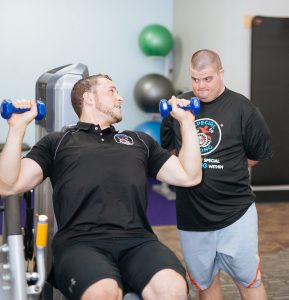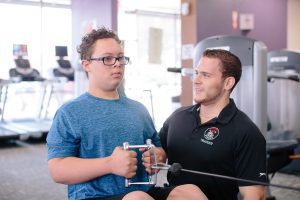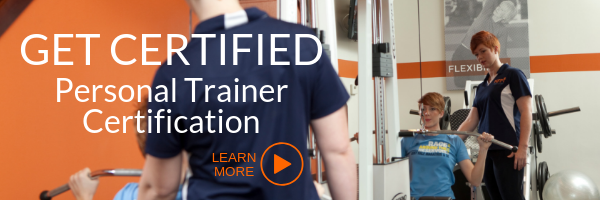Everyone needs a little help getting motivated and inspired to work out, especially those who haven’t discovered a “fun” way to stay in shape. If those who are able-bodied and able-minded have this hang-up with taking care of themselves, imagine the hurdles people with special needs must leap over to attain a healthy lifestyle. You can be the person who helps them achieve their fitness goals, making fitness accessible to all. Here’s how any trainer can work with a special needs client:
Don’t Make Assumptions
Get to know your client as an individual before assuming anything about their abilities. If you know your client has autism  upfront, you might mistakenly believe that they are dependent on you to explain each exercise, as if they’re new to fitness altogether. Your client may actually be very independent. They may even have a meticulous at-home workout regimen, depending on where they are on the spectrum, and may just need your guidance to overcome a plateau. When you take the time to learn each client’s individual abilities and fitness goals, you’ll both be successful.
upfront, you might mistakenly believe that they are dependent on you to explain each exercise, as if they’re new to fitness altogether. Your client may actually be very independent. They may even have a meticulous at-home workout regimen, depending on where they are on the spectrum, and may just need your guidance to overcome a plateau. When you take the time to learn each client’s individual abilities and fitness goals, you’ll both be successful.
Communicate Correctly With Your Special Needs Client
In the same way that you might assume your client has fewer abilities than they actually do, you might make the mistake of assuming your client won’t understand what you’re saying. Without meaning to, you may put on your “talking to a child” voice. If you’re working with a child with special needs, this may be perfectly fine, depending on their age and level of ability.
However, this tone is not acceptable when speaking with an adult with special needs. Treat your client with respect, and they will come to respect you too. When they respect you, they’ll be inclined to listen to your instructions. Without this respect, your time together is moot.
How you should communicate with your special needs client:
 When communicating with your special needs client, it’s important to point out their potential, express your belief in their abilities, and treat them with respect. Tell them you’re proud of them. Don’t raise your voice. (This sounds like a no-brainer, but you may feel compelled to raise your voice out of frustration or simply to get your point across.) Annunciation should do the trick.
When communicating with your special needs client, it’s important to point out their potential, express your belief in their abilities, and treat them with respect. Tell them you’re proud of them. Don’t raise your voice. (This sounds like a no-brainer, but you may feel compelled to raise your voice out of frustration or simply to get your point across.) Annunciation should do the trick.
Speak directly with your client, not their caretaker or their attendant. If your client is non-verbal, you can ask them “yes or no” questions that they can respond to with a nod or a shake of the head. You can even use devices for communicating with your client, if necessary.
The word “disability” is commonly used to describe your client’s diagnosis. It strengthens your bond with your client, however, and solidifies belief in their abilities if you avoid using that term with your client. We hate the term ourselves; it sounds like a curse word. Other words to avoid using (even when you’re just talking about your client, and not directly to them) include: “victim,” “retarded,” “handicapped,” “wheelchair-bound,” and any other label that puts your client’s physical limitations above their expectations.
How to communicate using ABA techniques:
Many special needs clients often engage in repetitive behaviors and phrases. Ignore these and wait them out. Part of your frustration can come from engaging in the repetition, but sometimes it’s enough for your client to know that you’re listening, or they may not even be doing it for your benefit. It might be stimming or a self-soothing strategy.
You can use visual aids to explain upcoming activities with your client. Taking pictures of your client doing a certain exercise and then showing them the picture later is a great way to cue them into the exercise again. Make sure to voice your praise when your client is making headway on their fitness goals, motivating them to do the workouts in the first place using if/then reward systems. For example, you might say, “If you do 10 sit-ups, you can jump on the mini-trampoline for cardio,” if you know this is
something your client enjoys.
Tap into Your Patience
You may be tempted to use your “talking to a child” voice at times, even when you’re with your adult clients with special needs, because of how often you have to repeat yourself or explain concepts you didn’t realize they wouldn’t understand. When you use this voice, you’re trying to mask your frustration and impatience, but to your adult clients, you’re simply revealing it.
When working with clients with an intellectual disability, you’re going to have to repeat yourself. A lot. That’s just part of the process. But slow progress is still progress nonetheless. Stick with it, and you’ll see your clients achieve their goals and even do things they never expected they could do.
Tips for Tapping into Your Patience
● Breathing Exercises
● Meditation
● Counting to Five Before Responding
● Yoga
● Waiting Without Distractions
Some of these exercises, you’ll perform while you’re not with your client, so you can ramp up a spirit of patience before you even meet with them. Things you’ll try outside of your sessions will include yoga, meditation, and waiting without distractions.
Implement Behavioral Therapy Techniques
While behavioral therapy is primarily used with clients with autism, the principles in it can be used universally with many other types of special needs, especially when it comes to working with another intellectual or cognitive disability. In our special needs certification, Special Education teaches a skill called “offering selection.” It’s a great idea to spend the first few sessions with a client, allowing them to choose 50% of the activities. It positively affects the self-efficacy of our clients for the better to say, “Listen, we need to do cardio on the treadmill and free weights. Which would you like to do first?”
We need to be conscientious about the ratio of choice. Once a client has shown that he or she can share control, we can let them make more decisions. It’s unlikely that your client will be 100% free to choose in many of life’s scenarios, so we can make our work in the gym mimic the real world ratios of choice and non-negotiables. Likely, a client sustaining at 20-25% choice is a reasonable goal.
Special Strong provides nutrition and adapted fitness for special needs children, adolescents, and adults with autism, Down syndrome, and other disabilities. Through our online training platform, we also provide special needs fitness certification courses for educators, professionals, and parents who want to learn how to adapt fitness to serve the special needs population.
 With fitness certifications through NASM, NFPT, and becoming a Certified Inclusive Fitness Trainer, Daniel Stein specializes in health and fitness for the special needs population. In 2016, Daniel and his wife, Trinity, started Special Strong. Special Strong provides nutrition and adapted fitness for special needs children, adolescents, and adults with autism, Down syndrome, and other disabilities. Through their online training platform, they also provide special needs fitness certification courses for educators, professionals, and parents who want to learn how to adapt fitness to serve the special needs population.
With fitness certifications through NASM, NFPT, and becoming a Certified Inclusive Fitness Trainer, Daniel Stein specializes in health and fitness for the special needs population. In 2016, Daniel and his wife, Trinity, started Special Strong. Special Strong provides nutrition and adapted fitness for special needs children, adolescents, and adults with autism, Down syndrome, and other disabilities. Through their online training platform, they also provide special needs fitness certification courses for educators, professionals, and parents who want to learn how to adapt fitness to serve the special needs population.
Guest authors offer experience and educational insights based on their specific area of expertise. These authors are contributing writers for the NFPT blog because they have valuable information to share with NFPT-CPTs and the fitness community at-large. If you are interested in contributing to the NFPT blog as a guest, please send us a note expressing your interest and tell us how you can contribute valuable insights to our readers. We look forward to hearing from you! Send to editor@nfpt.com


